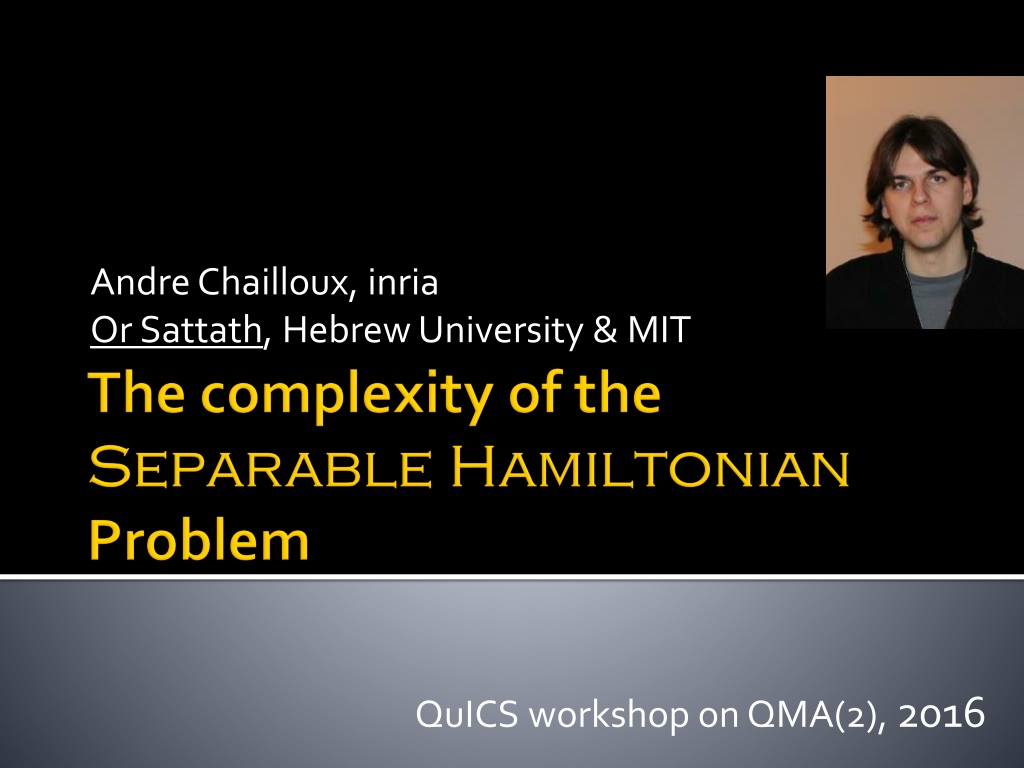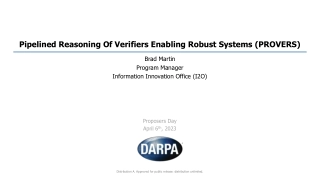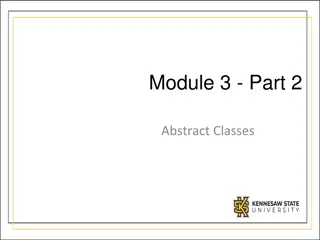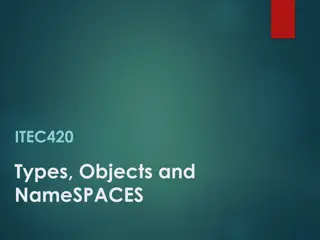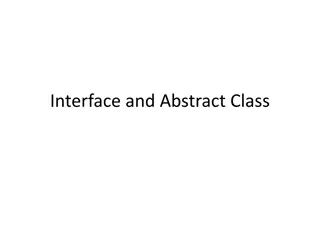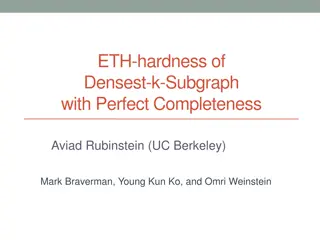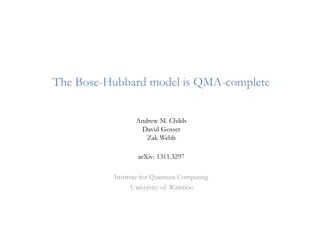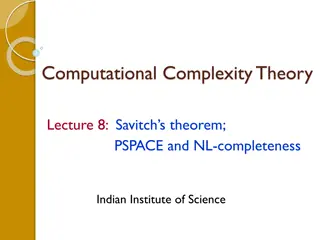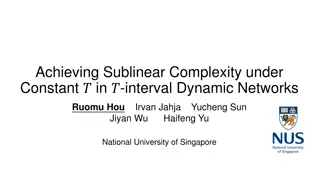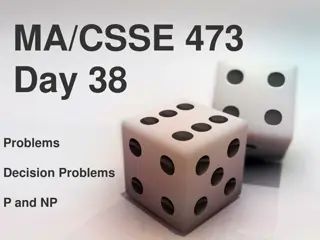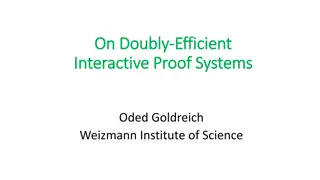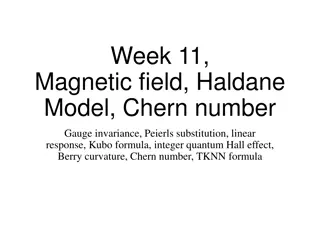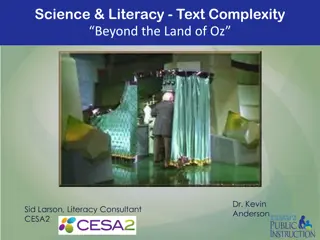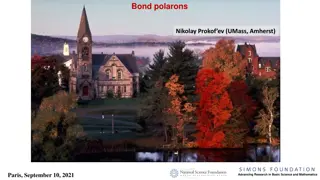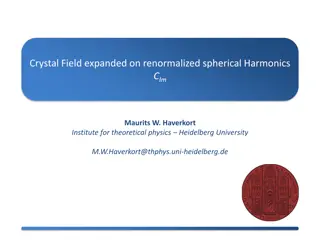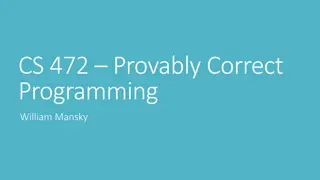Understanding QMA(2): Hamiltonians, Provers, and Complexity Classes
Exploring the complexities of QMA(2) through discussions on separable sparse Hamiltonians, the power of Merlin in L.QMA, the impact of prover restrictions on complexity classes like IP and MIP, and the difference between Merlin.A, Merlin.B, and Arthur in L.QMA(2). Delve into short proofs for NP-Complete problems, N-representability in QMA(2), and the challenges in proving upper bounds like QMA.PSPACE and QMA(2). Gain insights into the canonical QMA-Complete problem and its significance in quantum complexity theory.
Uploaded on Nov 14, 2024 | 0 Views
Download Presentation

Please find below an Image/Link to download the presentation.
The content on the website is provided AS IS for your information and personal use only. It may not be sold, licensed, or shared on other websites without obtaining consent from the author. Download presentation by click this link. If you encounter any issues during the download, it is possible that the publisher has removed the file from their server.
E N D
Presentation Transcript
Andre Chailloux, inria Or Sattath, Hebrew University & MIT QuICS workshop on QMA(2), 2016
Two variants of the Local-Hamiltonian problem. We show: Separable Sparse Hamiltonian is QMA(2)-Complete. Separable Local Hamiltonian is in QMA!
We have an entire toolbox for working with Hamiltonians. Might be a way to prove upperbounds on QMA(2)(next talk?). This difference between the sparse and local case is surprising.
Merlin is all powerful, but can be malicious, Arthur is skeptical, and limited to BQP. A problem L QMA if: x L | that Arthur accepts w.h.p. x L | Arthur rejects w.h.p. |?
Restricting the prover can increase the size of a complexity class: IP: MIP: =PSPACE =NEXP
Merlin A and Merlin B are all powerful, do not share entanglement. Arthur is skeptical, and limited to BQP. A problem L QMA(2) if: x L | 1 | 2 that Arthur accepts w.h.p. x L | 1 | 2 Arthur rejects w.h.p.
|?? |??
There are short proofs for NP-Complete problems in QMA(2) [BT 07,Beigi 10,LNN 11,ABD+`09]. Pure N-representability QMA(2) [LCV 07]. QMA(k) = QMA(2) [HM 10]. QMA PSPACE, while the best upper-bound we had was QMA(2) NEXP [KM 01]. Later today: attempt towards QMA(2) EXP [Schwarz 15], building on top of this result.
The canonical QMA-Complete problem. Problem: Given ? = ???, where each ?? acts non trivially on k qubits, decide whether there exists a state with energy below a or all states have energy above b? Witness: the state with energy below a. Verification: estimation of the energy.
Problem: Given ? = ???, and a partition of the qubits, decide whether there exists a separable state with energy at most a or all separable states have energies above b? A natural candidate for a QMA(2)-Complete problem. The witness: the separable state with energy below a.
Given a quantum circuit Q, a history state is a state of the form: ?? ?=0 ? ??, where ?? ?? ?1? . Kitaev s Hamiltonian gives an energetic penalty to: states which are not history states. history states are penalized for Pr(Q rejects |? ) ?
What happens if we use Kitaevs Hamiltonian for a QMA(2) circuit, and allow only separable witnesses? Problems: Even if ? = ?? |?? , then |?? is typically entangled. Even if ? |?? is separable , |?? is typically entangled. For this approach to work, one part must be fixed & non-entangled during the entire computation.
We need to assume that one part is fixed & non-entangled during the computation. Aram Harrow and Ashley Montanaro have shown exactly this! Thm: Every QMA(k) verification circuit can be transformed to a QMA(2) verification circuit with the following form:
|+ SWAP |? SWAP |? time
|+ SWAP |? SWAP |? The history state is a tensor product state: ? ? = ? ?? ?1? |? ?=0
There is a flaw in the argument: |+ SWAP |? Non-local operator! Causes H to be non-local! SWAP |?
Control-Swap over multiple qubits is sparse: 1 1 1 1 C-SWAP= . 1 1 1 1 The energy of sparse-Hamiltonians can be estimated, and therefore
Sparse Hamiltonians and Local Hamiltonians share the following properties: Every Local Hamiltonian is sparse Both variants can be simulated efficiently The energy of a Sparse Hamiltonian (just like a local Hamiltonian) can be estimated, and therefore Sparse Hamiltonian is QMA-Complete [Aharonv-Ta Shma 03] Simulation with exponentially small error to both [Berry et al. 13] We were used to think that whatever holds for local Hams. holds for sparse Hams.
Sparse HamiltonianQMA [Aharonv-Ta Shma 03]. Separable Sparse-Hamiltonian QMA(2), for the same reason. The instance that we constructed is local, except one term which is sparse. Theorem: Separable Sparse Hamiltonianis QMA(2)-Complete.
Theorem: Separable Sparse QMA(2)-Complete. Can we further prove: Separable Local Hamiltonian is QMA(2)-Complete? Sparse Hamiltonian is Local SWAP SWAP If we use the local implementation of C-SWAP, the history state becomes entangled. Seems like a technicality. Is it?
Thm 2: Separable Local HamiltonianQMA. Proof sketch: The prover sends the classical description of the reduced density matrices for ??, and ??. The verifier can calculate the energy classically: ?? ??? ?? = ??(????) ? The prover also sends a quantum proof that these two states (with these reduced density matrices) exist.
Consistensy of Local Density Matrices Problem (CLDM): Input: density matrices ?1, ,?? over k qubits and sets ?1, ,?? {1, ,?}. Output: yes, if there exists an n-qubit state ? which is consistent: ? ?, ???= ??. No, otherwise. Theorem[Liu`06]: CLDM QMA.
The prover sends: a) Classical part, containing the reduced density matrices of ??, and ??. b) A quantum proof for the fact that ?? exists, and similarly, that ?? exists. The verifier: a) classically verifies that the energy is below the threshold a, assuming that the state is ?? ??. b) verifies that there exists such a state ?? and ??, using the CLDM protocol.
When ?? involves both parts, the verifier assumes that the state is ?? ??. It exists because the prover already proved the existence of both ?? and ??.
Known results: Local Hamiltonian & Sparse Hamiltonian are QMA-Complete. A reasonable guess would be that their Separable version are either QMA(2)-Complete, or QMA- Complete, but it turns out this is wrong. Separable Sparse Hamiltonian is QMA(2)- Complete. Separable Local Hamiltonian is QMA- Complete.
Similar to CLDM, but with the additional requirement that the state is pure (i.e. not a mixed state). In QMA(2): verifier receives 2 copies, and estimates the purity using the swap test: Pr(? ?passes the swap test) = ?? ?? Is pure N-representability QMA(2)-Complete? ??(?2).
L in QRG(1) if: ? ? ? ?Pr ? ??????? ? ? 2/3 ? ? ? ?Pr ? ??????? ? ? 1/3 Refereed Hamiltonian Problem: ? ? ? ? ?? ? ? ? ? ? ? ? ? ?? ? ? ? ? where b-a < 1/poly(n) Is Refereed local / sparse Hamiltonian QRG(1)- Complete? Known results: P??? ???? 1= ??? 1 ??? 2 = ?????? ??? = ???
